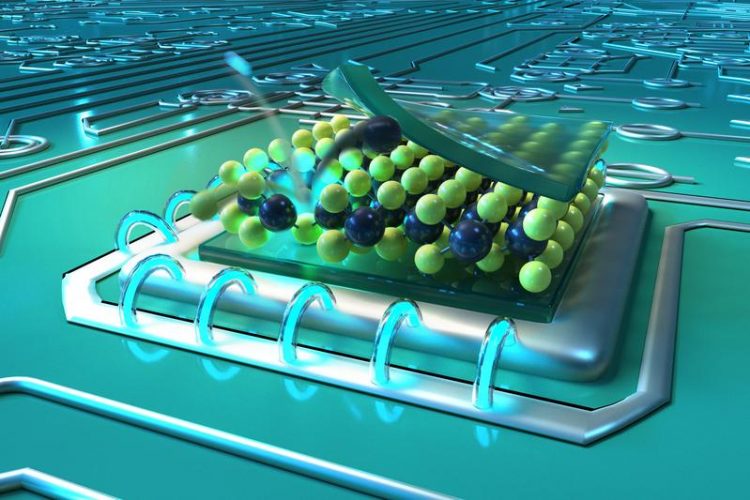Quantum light sources pave the way for optical circuits: Light in the nanoworld

Defects in thin molybdenum sulfide layers, generated by bombardment with helium ions, can serve as nano-light sources for quantum technologies. Image: Christoph Hohmann / MCQST
Previous circuits on chips rely on electrons as the information carriers. In the future, photons which transmit information at the speed of light will be able to take on this task in optical circuits. Quantum light sources, which are then connected with quantum fiber optic cables and detectors are needed as basic building blocks for such new chips.
An international team headed up by TUM physicists Alexander Holleitner and Jonathan Finley has now succeeded in creating such quantum light sources in atomically thin material layers and placing them with nanometer accuracy.
First step towards optical quantum computers
“This constitutes a first key step towards optical quantum computers,” says Julian Klein, lead author of the study. “Because for future applications the light sources must be coupled with photon circuits, waveguides for example, in order to make light-based quantum calculations possible.”
The critical point here is the exact and precisely controllable placement of the light sources. It is possible to create quantum light sources in conventional three-dimensional materials such as diamond or silicon, but they cannot be precisely placed in these materials.
Deterministic defects
The physicists then used a layer of the semiconductor molybdenum disulfide (MoS2) as the starting material, just three atoms thick. They irradiated this with a helium ion beam which they focused on a surface area of less than one nanometer.
In order to generate optically active defects, the desired quantum light sources, molybdenum or sulfur atoms are precisely hammered out of the layer. The imperfections are traps for so-called excitons, electron-hole pairs, which then emit the desired photons.
Technically, the new helium ion microscope at the Walter Schottky Institute’s Center for Nanotechnology and Nanomaterials, which can be used to irradiate such material with an unparalleled lateral resolution, was of central importance for this.
On the road to new light sources
Together with theorists at TUM, the Max Planck Society, and the University of Bremen, the team developed a model which also describes the energy states observed at the imperfections in theory.
In the future, the researchers also want to create more complex light source patterns, in lateral two-dimensional lattice structures for example, in order to thus also research multi-exciton phenomena or exotic material properties.
This is the experimental gateway to a world which has long only been described in theory within the context of the so-called Bose-Hubbard model which seeks to account for complex processes in solids.
Quantum sensors, transistors and secure encryption
And there may be progress not only in theory, but also with regard to possible technological developments. Since the light sources always have the same underlying defect in the material, they are theoretically indistinguishable. This allows for applications which are based on the quantum-mechanical principle of entanglement.
“It is possible to integrate our quantum light sources very elegantly into photon circuits,” says Klein. “Owing to the high sensitivity, for example, it is possible to build quantum sensors for smartphones and develop extremely secure encryption technologies for data transmission.”
More information:
The work was supported by the Deutsche Forschungsgemeinschaft (DFG, German Research Foundation), by the TUM International Graduate School of Science and Engineering (IGSSE), by the clusters of excellence “Nanosystems Initiative Munich” (NIM), “Munich Center for Quantum Science and Technology” (MCQST) and “e-conversion”, the TUM Institute for Advanced Study, the ExQM doctoral program of the Bavarian Elite Network, by the European Union in the context of Horizon 2020, the Photonics Research Germany funding program, and the Bavarian Academy of Sciences and Humanities.
Alongside scientists from the Technical University of Munich, researchers of the Max Planck Institute for Quantum Optics (Garching), the University of Bremen, The State University of New York (Buffalo, USA) and the National Institute for Materials Science (Tsukuba, Japan) were also involved.
Prof. Dr. Alexander W. Holleitner
Walter Schottky Institute and Department of Physics
Center for Nanotechnologie and Nanomaterials
Technical University of Munich
Am Coulombwall 4a, 85748 Garching, Germany
Tel.: +49 89 289 11575 – E-Mail: holleitner@wsi.tum.de
Web: https://www.wsi.tum.de/views/sub_group.php?group=Holleitner
Prof. Dr. Jonathan J. Finley
Walter Schottky Institute and Department of Physics
Technical University of Munich
Am Coulombwall 4, 85748 Garching, Germany
Tel.: +49 89 289 12770 – E-Mail: jonathan.finley@wsi.tum.de
Web: https://www.wsi.tum.de/views/groups.php?group=finley
Site-selectively generated photon emitters in monolayer MoS2 via local helium ion irradiation
J. Klein, M. Lorke, M. Florian, F. Sigger, L. Sigl, S. Rey, J. Wierzbowski, J. Cerne, K. Müller, E. Mitterreiter, P. Zimmermann, T. Taniguchi, K. Watanabe , U. Wurstbauer, M. Kaniber, M. Knap, R. Schmidt, J.J. Finley & A.W. Holleitner
Nature Communications, 10, 2755 (2019) – DOI: 10.1038/s41467-019-10632-z
https://doi.org/10.1038/s41467-019-10632-z
https://www.tum.de/nc/en/about-tum/news/press-releases/details/35627/ Link to the press release
Media Contact
All latest news from the category: Physics and Astronomy
This area deals with the fundamental laws and building blocks of nature and how they interact, the properties and the behavior of matter, and research into space and time and their structures.
innovations-report provides in-depth reports and articles on subjects such as astrophysics, laser technologies, nuclear, quantum, particle and solid-state physics, nanotechnologies, planetary research and findings (Mars, Venus) and developments related to the Hubble Telescope.
Newest articles

A ‘language’ for ML models to predict nanopore properties
A large number of 2D materials like graphene can have nanopores – small holes formed by missing atoms through which foreign substances can pass. The properties of these nanopores dictate many…

Clinically validated, wearable ultrasound patch
… for continuous blood pressure monitoring. A team of researchers at the University of California San Diego has developed a new and improved wearable ultrasound patch for continuous and noninvasive…

A new puzzle piece for string theory research
Dr. Ksenia Fedosova from the Cluster of Excellence Mathematics Münster, along with an international research team, has proven a conjecture in string theory that physicists had proposed regarding certain equations….



